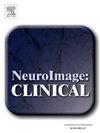Exploring the effect of multi-modal intervention against cognitive decline on atrophy and small vessel disease imaging markers in the AgeWell.de imaging study
IF 3.6
2区 医学
Q2 NEUROIMAGING
引用次数: 0
Abstract
Background
Multimodal lifestyle interventions might help to maintain healthy cognition in older age and to delay onset of dementia. Here, we studied the effects of a multi-modal lifestyle-based intervention, based on the FINGER trial, on magnetic resonance imaging (MRI) markers of hippocampal-limbic atrophy and cerebral small vessel disease in older adults at increased risk for dementia in Germany.
Methods
Leipzig participants of the multicenter AgeWell.de randomized controlled trial underwent neuroimaging before and after a two year intervention at 3 Tesla MRI. We extracted hippocampal volume and entorhinal cortex thickness (ECT), free water fraction (FW), peak width of skeletonized mean diffusivity (PSMD), white matter hyperintensity volume and mean gray matter cerebral blood flow and assessed the effect of the intervention on these imaging markers using linear mixed models. We also tested the effect of the intervention on the hippocampus-dependent Mnemonic Similarity Test and fixel-based white matter microstructure.
Results
56 individuals (mean (sd) age: 68.8 (4.2) years, 26 females, 24/32 intervention/control group) were included at baseline and 41 returned after an average of 28 months for the second assessment. ECT and FW exhibited stronger decline in the intervention compared to the control group in preregistered models but not when adjusted for baseline differences. All other markers progressed similarly across groups, however sample size was smaller than expected. In exploratory analyses, cerebral blood flow increased more in the intervention group and this change was associated with decreases in systolic blood pressure.
Conclusions
In this group of older adults at risk for dementia, we find no conclusive evidence whether a multi-modal lifestyle intervention improves brain imaging markers of neurodegeneration and small vessel disease. Preliminary evidence suggested an association of the intervention, increased cerebral blood flow and systolic blood pressure reductions.
Abbreviations: ECT, entorhinal cortex thickness; FW, free water fraction; WHO, world health organization; AD, Alzheimer’s disease; VCI, vascular cognitive impairment; FINGER, Finnish Geriatric Intervention Study to Prevent Cognitive Impairment and Disability; MTL, medial temporal lobe; MIND, Mediterranean-DASH Intervention for Neurodegenerative Delay diet; cSVD, cerebral small vessel disease; WMH, white matter hyperintensities of presumed vascular origin; PSMD, peak width of the mean diffusivity distribution; WW-FINGERS, world wide FINGER studies; CAIDE, Cardiovascular Risk Factors, Aging, and Incidence of Dementia; GPP, general practitioner praxis; MRI, magnetic resonance imaging; MST, Mnemonic Similarity Test; TE, echo time; TR, repetition time; FA, flip angle; FOV, field of view; GRAPPA, GeneRalized Autocalibrating Partial Parallel Acquisition; CMRR, Center for Magnetic Resonance Research; BOLD, blood oxygenation level dependent; pcASL: pseudo-continuous arterial spin labeling; EPI, echo-planar imaging; FLAIR, fluid attenuated inversion recovery; CBF, cerebral blood flow; QA, quality assessment; GM, gray matter; HCV, hippocampal volume; eICV, estimated intracranial volume; DWI, diffusion-weighted imaging; MD, mean diffusivity; FA, fractional anisotropy
TBSS: tract-based spatial statistics; CSF, cerebral spinal fluid; ISI, inter-stimulus interval; LDI, lure discrimination index; REC, recognition score; CG, control group; IG, intervention group; MoCA, Montreal Cognitive Assessment; CASMIN, Comparative Analysis of Social Mobility in Industrial Nations; BMI, body mass index; SBP/DBP, systolic/diastolic blood pressure; OSF, open science framework; LMM, linear mixed model; ANOVA, analysis of covariance.
在AgeWell.de影像学研究中探讨多模式干预对认知能力下降对萎缩和小血管疾病影像学标志物的影响
背景:多模式生活方式干预可能有助于维持老年人的健康认知,并延缓痴呆症的发病。在这里,我们研究了基于FINGER试验的多模式生活方式干预对德国痴呆风险增加的老年人海马-边缘萎缩和脑血管疾病的磁共振成像(MRI)标志物的影响。方法多中心AgeWell.de随机对照试验的参与者在干预前和干预后2年接受3特斯拉MRI神经影像学检查。我们提取海马体积和内鼻皮层厚度(ECT)、游离水分数(FW)、骨化平均扩散率(PSMD)峰宽、白质高强度体积和平均灰质脑血流量,并采用线性混合模型评估干预对这些成像标志物的影响。我们还测试了干预对海马体依赖性记忆相似性测试和固定基白质微观结构的影响。结果基线时纳入56例(平均(sd)年龄:68.8(4.2)岁,女性26例,干预/对照组24/32例),41例在平均28个月后返回进行第二次评估。在预先注册的模型中,ECT和FW在干预中比对照组表现出更强的下降,但在调整基线差异时则没有。所有其他标记在各组间的进展相似,但样本量比预期的要小。在探索性分析中,干预组脑血流量增加更多,这种变化与收缩压降低有关。结论:在这组有痴呆风险的老年人中,我们没有发现多模式生活方式干预是否能改善神经变性和小血管疾病的脑成像标志物的确凿证据。初步证据表明干预与脑血流量增加和收缩压降低有关。缩写:ECT,内嗅皮层厚度;FW:游离水分数;卫生组织,世界卫生组织;AD,阿尔茨海默病;VCI,血管性认知障碍;芬兰老年干预研究预防认知障碍和残疾;内侧颞叶;MIND,地中海- dash干预神经退行性延迟饮食;cSVD,脑血管病;WMH,推定血管来源的白质高信号;PSMD,平均扩散系数分布的峰宽;WW-FINGERS,世界范围的手指研究;CAIDE,心血管危险因素,衰老和痴呆发病率;全科医生执业;MRI,磁共振成像;助记相似性检验;TE,回波时间;TR:重复时间;FA,翻转角度;FOV,视场;GRAPPA,广义自校准部分并行采集中国科学院磁共振研究中心;BOLD,血氧水平依赖性;pcASL:伪连续动脉自旋标记;EPI,回波平面成像;FLAIR,流体衰减反演采收率;CBF,脑血流量;QA,质量评估;GM,灰质;HCV,海马体积;eICV,估计颅内容积;DWI,弥散加权成像;MD:平均扩散系数;FA,分数各向异性
TBSS:基于束的空间统计;CSF,脑脊液;ISI,刺激间间隔;LDI,诱饵辨别指数;REC,识别分数;CG,对照组;IG,干预组;蒙特利尔认知评估;CASMIN:工业国家社会流动的比较分析BMI,身体质量指数;SBP/DBP,收缩压/舒张压;OSF,开放科学框架;LMM,线性混合模型;协方差分析。
本文章由计算机程序翻译,如有差异,请以英文原文为准。
求助全文
约1分钟内获得全文
求助全文
来源期刊

Neuroimage-Clinical
NEUROIMAGING-
CiteScore
7.50
自引率
4.80%
发文量
368
审稿时长
52 days
期刊介绍:
NeuroImage: Clinical, a journal of diseases, disorders and syndromes involving the Nervous System, provides a vehicle for communicating important advances in the study of abnormal structure-function relationships of the human nervous system based on imaging.
The focus of NeuroImage: Clinical is on defining changes to the brain associated with primary neurologic and psychiatric diseases and disorders of the nervous system as well as behavioral syndromes and developmental conditions. The main criterion for judging papers is the extent of scientific advancement in the understanding of the pathophysiologic mechanisms of diseases and disorders, in identification of functional models that link clinical signs and symptoms with brain function and in the creation of image based tools applicable to a broad range of clinical needs including diagnosis, monitoring and tracking of illness, predicting therapeutic response and development of new treatments. Papers dealing with structure and function in animal models will also be considered if they reveal mechanisms that can be readily translated to human conditions.
 求助内容:
求助内容: 应助结果提醒方式:
应助结果提醒方式:


